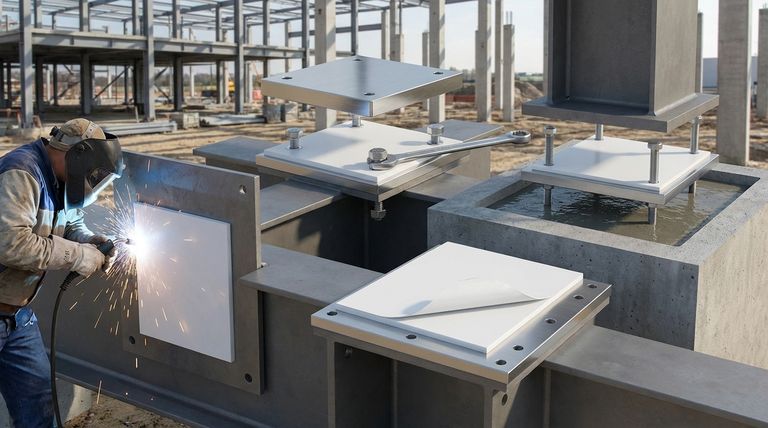The primary installation methods for PTFE slide bearings are full welding, tack welding, bolting, and mortar embedment. These methods provide the versatility to integrate bearings into a wide range of steel and concrete structures, from long-span buildings and bridges to heavy industrial equipment. The selection of a specific method is dictated by the structural design, material type, and the need for future adjustability.
The core decision is not just about the installation method itself, but about matching the bearing type and its attachment to the specific structural material—steel or concrete—and the performance requirements of the connection, whether permanent or adjustable.

Deconstructing the Installation Methods
Each installation method serves a distinct purpose, tailored to different structural connections and materials. Understanding their fundamental differences is the first step in making an informed decision.
Full Welding
Full welding creates a permanent, monolithic bond between the bearing's backing plate and the steel structure. This method is chosen when the bearing is intended to be a permanent, non-adjustable part of the structural assembly. It offers the most rigid and durable connection for steel-to-steel applications.
Tack Welding
Tack welding involves applying short, intermittent welds to secure the bearing's backing plate. This approach is often used for temporary positioning or when a full-strength weld is not required by the design. It offers a faster installation than full welding but a less robust permanent connection.
Bolting
Bolting offers a strong mechanical connection that allows for potential adjustment, removal, or replacement. This method is ideal for applications where precise alignment is critical or where future access to the bearing may be necessary. The bearing's backing plate comes pre-drilled to specified bolt patterns.
Mortar Embedment
This method is used exclusively for integrating the slide bearing into concrete structures. The backing plate is designed with anchors or shear studs that are embedded into wet concrete or secured with grout, creating a fixed connection once the mortar cures.
Understanding the Key Considerations
Choosing the right installation method requires looking beyond the connection itself and considering the entire structural system and environment.
The Role of Backing Plates
The slide bearing consists of the PTFE surface bonded to a steel backing plate. The installation method attaches this backing plate to the structure, not the PTFE itself. Therefore, the thickness and material of the backing plate must be specified to be compatible with the chosen method.
Structural Material (Steel vs. Concrete)
The most fundamental factor is the material of the connecting members. Welding and bolting are reserved for steel structures. Mortar embedment is the standard method for concrete foundations, piers, or beams.
Protecting the PTFE Surface
The low-friction PTFE surface is the most critical component of the bearing and is sensitive to damage. During installation, the PTFE must be protected from weld spatter, paint overspray, and any metal debris or swarf. Failure to do so can degrade or destroy its slide characteristics.
Bearing Orientation is Critical
For standard white PTFE, the correct assembly is non-negotiable. The PTFE pad should always be installed on the lower structural member, facing up. The corresponding upper member must have a polished stainless steel surface to slide against. Reversing this orientation can trap debris and impede movement.
Making the Right Choice for Your Structure
Your project's specific requirements will point directly to the optimal installation method.
- If your primary focus is a permanent connection in a steel structure: Choose full welding for maximum strength and rigidity.
- If your primary focus is adjustability or future replacement in a steel structure: Choose bolting for its mechanical precision and serviceability.
- If your primary focus is integrating the bearing into a concrete foundation or member: Mortar embedment is the correct and only method.
- If your primary focus is a temporary hold or partial connection on steel: Tack welding can be a viable and efficient option.
Ultimately, selecting the correct installation method ensures the slide bearing functions as designed, effectively managing structural forces for the life of the asset.
Summary Table:
| Installation Method | Primary Use Case | Key Characteristic |
|---|---|---|
| Full Welding | Steel Structures | Permanent, rigid, monolithic connection |
| Tack Welding | Steel Structures | Temporary hold or partial connection |
| Bolting | Steel Structures | Adjustable, removable, allows for precise alignment |
| Mortar Embedment | Concrete Structures | Fixed connection for foundations and piers |
Ensure Optimal Performance for Your Project
Choosing the correct installation method is critical for the long-term performance of your PTFE slide bearings. The experts at KINTEK are here to help.
We manufacture high-precision PTFE components, including custom slide bearings, for the semiconductor, medical, laboratory, and industrial sectors. Our team can provide technical guidance on selecting and specifying the right bearing and installation method for your specific structural design, material, and performance requirements—from prototype to high-volume production.
Contact us today to discuss your project needs and receive a quote.
Visual Guide

Related Products
- Custom PTFE Parts Manufacturer for Teflon Parts and PTFE Tweezers
- Custom PTFE Parts Manufacturer for Teflon Containers and Components
- Customizable PTFE Rods for Advanced Industrial Applications
- Custom PTFE Teflon Balls for Advanced Industrial Applications
- Custom PTFE Sleeves and Hollow Rods for Advanced Applications
People Also Ask
- What fabrication services are available for PTFE? Shearing, Stamping, Laser Cutting, Molding & Machining
- What chemical processing applications involve PTFE-machined parts? Essential Components for Corrosive & High-Purity Systems
- What are the main applications of PTFE type Teflon? Unlock Its Versatility for Your Industry
- What industrial benefits do PTFE-machined parts offer? Achieve Peak Performance in Demanding Applications
- What challenges arise when machining PTFE (Teflon)? Overcome Softness, Heat, and Instability



















